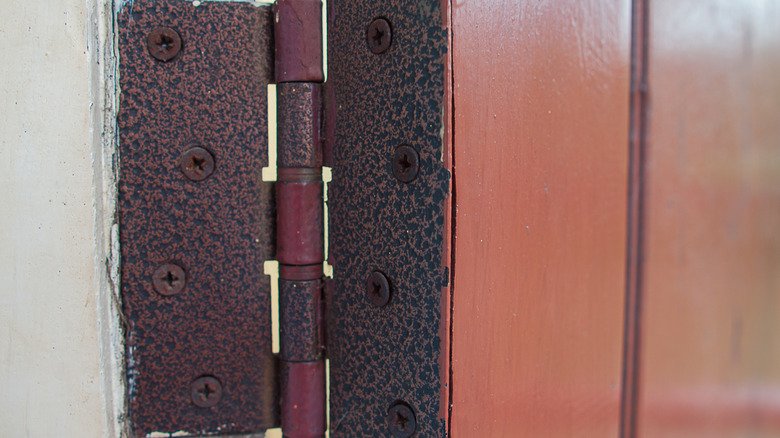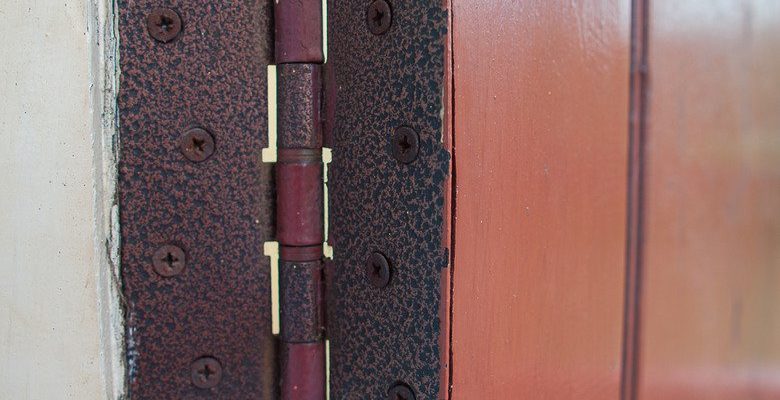
But the elements aren’t kind. Rain, humidity, or even just morning dew will try to sneak into every crack. If you ignore your hinges, rust can creep in before you know it, turning smooth movement into a sticky, squeaky hassle. Whether you’ve got a classic Schlage lockset or a solid Kwikset deadbolt, those brands rely on strong, well-maintained hinges as much as any lock. Keeping them clean and rust-free isn’t complicated, but it does take some regular attention.
Let’s run through what actually causes rust, how to fix it if you see it, and (maybe most important of all) how to stop it from coming back. You don’t need fancy tools or special skills. Just a little time, some common household supplies, and the right habits can make your exterior door hinges last for years.
Why Do Exterior Door Hinges Rust So Quickly?
Take a minute to picture where your door hinges live. They’re right out there, facing sun, rain, wind, and sometimes snow. If your door faces east or north, it probably gets hit hardest by morning dampness or stormy weather. Most exterior door hinges are made from steel or iron, and even though some are coated or “galvanized” to fend off corrosion, those layers don’t last forever.
Here’s the thing: rust is really just iron reacting with water and oxygen. The process is called oxidation. If a hinge’s protective layer gets scratched, worn down, or just wasn’t great in the first place, moisture will find its way in. It doesn’t take much—a little morning fog, an unnoticed leak, or a couple of wet days—and suddenly you’ve got rust spots.
If you live in a humid climate or near saltwater, you might notice it happens faster. Even high-quality brand-name hinges like Baldwin, Emtek, or Stanley can eventually start to corrode if you don’t do a little routine care. Rust isn’t just ugly, either. Over time, it’ll make your door harder to open and close, creating noise, stiffness, and even structural damage.
How To Tell If Your Exterior Door Hinges Need Cleaning
You might be wondering if your hinges are overdue for a cleaning. Here’s what to look for:
- Squeaking or creaking noises: This isn’t always rust, but it’s a solid clue that things are dry or dirty.
- Stiff and sticky movement: If your door fights you or “sticks” while opening, debris or corrosion might be building up.
- Visible rust or discoloration: Any reddish-brown powder or flaking metal means rust is starting to take hold.
- Dusty or grimy build-up: Even if you don’t see rust yet, layers of dirt trap moisture, setting the stage for corrosion down the line.
Don’t wait until the hinge looks like a relic from a haunted house. When you spot any of these signs—even a little squeak or spot of rust—it’s a cue to act. A small effort now prevents a big headache (and possible repair bill) later.
Step-By-Step: Cleaning Your Exterior Door Hinges
Let me explain how you can safely and easily clean your door hinges—no handyman needed. Here’s the full process I recommend:
- Gather supplies: Grab a screwdriver, a rag, a toothbrush (an old one works great), mild soap, water, a little white vinegar, and some light oil (like 3-in-1 or WD-40).
- Remove the door (optional but better): If you want to do a deep clean, it helps to take the door off its hinges. Just prop it carefully and unscrew the hinge pins.
- Scrub the hinge: Mix soap and warm water, then use the toothbrush to loosen dirt and grime. For stubborn rust, dab on a little vinegar and scrub gently.
- Rinse and dry: Wipe down all metal parts with a damp rag, then dry them thoroughly. Water left behind can actually make rust worse.
- Lubricate: Add a few drops of light oil to the hinge pin and moving parts. Work the hinge back and forth to spread the oil evenly.
- Reinstall: If you removed the door, put the hinge pins back and check that everything swings smoothly.
Take your time with the cleaning and drying steps—that’s where the magic happens. Rushing through just leaves moisture behind, which can kickstart new rust.
You don’t need to do this every week. Once or twice a year is usually plenty, unless you live right on the coast or in a super-humid spot.
Choosing The Right Cleaner And Lubricant For Door Hinges
Not every cleaner is hinge-friendly. Some harsh chemicals can strip away protective coatings, making it easier for rust to start. Here’s what works best for most exterior door hinges:
- Mild soap and water: Safe for most finishes, perfect for loosening dirt and dust.
- White vinegar: Great for removing early spots of rust, but don’t soak your hinges for hours—just a quick scrub.
- WD-40 or 3-in-1 oil: Excellent for lubrication, but apply sparingly to avoid sticky build-up.
- Silicone spray: This is ideal if you want long-lasting, residue-free lubrication (especially for smart locks or electronic doors).
Avoid bleach, ammonia, or anything abrasive. They can damage the finish—even on big-name brands like Schlage or Emtek. If you’re not sure what kind of finish you have (brass, nickel, stainless steel), test on a small hidden spot first.
How To Prevent Rust From Coming Back
So you’ve cleaned and lubed your hinges—now what? If you live somewhere with a lot of rain or salty air, you know rust can sneak back in quick. Here’s how to stay ahead of it:
- Regular checks: Every couple of months, give your hinges a quick glance and a test swing.
- Keep them dry: After heavy storms, wipe down the hinges if you see water beading up.
- Reapply lubricant: A fresh coat every season or after big weather changes helps keep everything moving smoothly and blocks out moisture.
- Touch up paint or finish: If you see chipping on your painted or coated hinges, touch them up—it’s not just about looks, it’s about protection.
Maintenance is easier than repair. It’s like flossing your teeth—two minutes now saves you from serious hassle later.
Honestly, these little habits make a huge difference. It’s not hard work, but it keeps your door swinging without drama year after year.
Replacing Rusty Hinges: When Is It Time?
You might be wondering if cleaning is enough, or if there’s a point when you just have to swap out the hinges. Here’s my rule of thumb: If the rust is only on the surface and the hinges are still moving fine, clean away. But if:
- The hinge feels wobbly or loose
- There’s deep pitting or chunks missing from the metal
- The screws don’t tighten because the rust has eaten the threads
…it’s probably time to toss those hinges and grab new ones.
Don’t be afraid to upgrade, either. Modern hinges are often made from stainless steel or powder-coated materials that hold up much better against the weather. Universal replacement hinges work for most doors, but if you’ve got a fancy lockset or a high-security entry (think smart locks or keyless systems), check the brand’s specs to make sure everything fits and syncs up.
And here’s a final tip: if you’re swapping hinges and want the new ones to last, give them a quick coat of spray lubricant or rust-inhibiting paint before you install them. A tiny investment up front can save you a lot of future troubleshooting.
Comparing Universal And Brand-Specific Hinges For Exterior Doors
Let’s say you’re in the hardware aisle and staring down a wall of options. Do you go with universal hinges (those generic, fits-any-door models) or should you splurge for the brand-name piece from Schlage, Kwikset, or Baldwin?
Here’s how they stack up:
- Universal hinges: Cheaper, easier to find, and honestly, they work for most basic doors. Just double-check the hole spacing and pin size.
- Brand-specific hinges: These are matched to your lockset and finishes, so you’ll get a perfect fit and consistent look. They’re usually pricier but better for doors with advanced features or smart lock sync.
- Material matters: Stainless steel, coated brass, or powder-coated steel will always fight rust better than bare steel.
If your door has cables for electronic locks or a battery-powered access system, I’d stick with the brand’s own hinges to avoid any weird troubleshooting surprises later.
Final Thoughts: Keeping Exterior Door Hinges Clean And Rust-Free
Looking after your exterior door hinges isn’t glamorous, but it’s one of those little things that makes a house feel solid and dependable. A few minutes of cleaning and oiling every year keeps rust from sneaking in, saves your hardware, and helps your door lock and latch work like new—no matter the brand.
Whether you’re working with universal hardware or matching a Schlage or Kwikset set, the routine is the same: clean, dry, lube, and check in every so often. Trust me, it’s easier than dealing with a stuck or screechy door on a rainy morning. Treat your hinges right, and they’ll swing smooth and silent for years to come.
